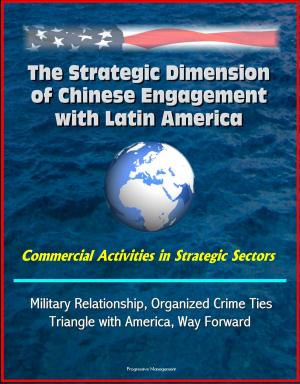20th Century Spy in the Sky Satellites: Secrets of the National Reconnaissance Office (NRO) Volume 3 - SAMOS Electro-optical Readout Satellite and the Lunar Orbiter Mapping Camera
Nonfiction, Science & Nature, Science, Physics, Astronomy, History, Military| Author: | Progressive Management | ISBN: | 9781466144552 |
| Publisher: | Progressive Management | Publication: | October 22, 2011 |
| Imprint: | Smashwords Edition | Language: | English |
| Author: | Progressive Management |
| ISBN: | 9781466144552 |
| Publisher: | Progressive Management |
| Publication: | October 22, 2011 |
| Imprint: | Smashwords Edition |
| Language: | English |
Part of our comprehensive series on the National Reconnaissance Office (NRO) and its "spy satellite" network, this volume covers the SAMOS satellite camera system and the incredible story of NASA's use of the camera in its highly successful Lunar Orbiter moon mapping program.
The previously classified documents in this collection, converted for accurate flowing-text e-book format reproduction, were released by the NRO in September 2011 as part of its 50th anniversary. In declassifying these fascinating documents, the NRO has opened the curtain to show the tremendous challenges that were overcome to achieve the impressive successes that help win the Cold War.
Conceived in the mid-1950s, the novel SAMOS imaging system at that time represented cutting edge technology—a near real time analog film-readout satellite. The Eastman Kodak Company built the E-1 (preliminary) and E-2 (advanced) payloads. The E-1 featured a six-inch focal length lens in a camera that spooled a special two-component EKC Bimat (positive) film, and SO-243 (negative) film. The exposed negative film, converged with the gelatin-coated SO-111 Bimat film, was developed in a semi-dry chemical process, and then was scanned by a Columbia Broadcasting System flying spot line-scanner that consisted of a cathode-ray tube and a rotating anode having a high intensity spot of light. A photomultiplier converted the light passing from the scanner through the film into an electrical signal whose strength varied with the density of the emulsion layer of the film. The images were then radioed to Earth as frequency-modulated analog signals, to be assembled much in the manner of a wire photo, each image built up in swaths.
Having acquired, launched, and then terminated work on a near real time imaging satellite, NRO officials at that time agreed to consign the SAMOS imaging system to the National Aeronautics and Space Administration (NASA) for use in its deep space exploration program. The surreptitious transfer of this technology, a fact just recently declassified, has remained unknown to many in the NRO and NASA because of the compartmented security measures then in place.
The first three of the Lunar Orbiters completed the original task of obtaining detailed photographs needed to select Apollo landing sites. That left the last two film-readout near real time imaging satellites available to photo-map virtually the entire moon and examine in detail various surface features. Collectively, these images of the Earth's natural satellite proved a selenographic bonanza that paved the way for Project Apollo's manned lunar landings later in the decade.
NRO designs, builds and operates the nation's reconnaissance satellites. NRO products, provided to an expanding list of customers like the Central Intelligence Agency (CIA) and the Department of Defense (DoD), can warn of potential trouble spots around the world, help plan military operations, and monitor the environment. As part of the 16-member Intelligence Community, the NRO plays a primary role in achieving information superiority for the U. S. Government and Armed Forces. A DoD agency, the NRO is staffed by DoD and CIA personnel. It is funded through the National Reconnaissance Program, part of the National Foreign Intelligence Program. The NRO Vision: Vigilance From Above. NRO Mission: Innovative Overhead Intelligence Systems for National Security. In recent years, the NRO has implemented a series of actions declassifying some of its operations. The organization was declassified in September 1992 followed by the location of its headquarters in Chantilly, VA, in 1994.
Part of our comprehensive series on the National Reconnaissance Office (NRO) and its "spy satellite" network, this volume covers the SAMOS satellite camera system and the incredible story of NASA's use of the camera in its highly successful Lunar Orbiter moon mapping program.
The previously classified documents in this collection, converted for accurate flowing-text e-book format reproduction, were released by the NRO in September 2011 as part of its 50th anniversary. In declassifying these fascinating documents, the NRO has opened the curtain to show the tremendous challenges that were overcome to achieve the impressive successes that help win the Cold War.
Conceived in the mid-1950s, the novel SAMOS imaging system at that time represented cutting edge technology—a near real time analog film-readout satellite. The Eastman Kodak Company built the E-1 (preliminary) and E-2 (advanced) payloads. The E-1 featured a six-inch focal length lens in a camera that spooled a special two-component EKC Bimat (positive) film, and SO-243 (negative) film. The exposed negative film, converged with the gelatin-coated SO-111 Bimat film, was developed in a semi-dry chemical process, and then was scanned by a Columbia Broadcasting System flying spot line-scanner that consisted of a cathode-ray tube and a rotating anode having a high intensity spot of light. A photomultiplier converted the light passing from the scanner through the film into an electrical signal whose strength varied with the density of the emulsion layer of the film. The images were then radioed to Earth as frequency-modulated analog signals, to be assembled much in the manner of a wire photo, each image built up in swaths.
Having acquired, launched, and then terminated work on a near real time imaging satellite, NRO officials at that time agreed to consign the SAMOS imaging system to the National Aeronautics and Space Administration (NASA) for use in its deep space exploration program. The surreptitious transfer of this technology, a fact just recently declassified, has remained unknown to many in the NRO and NASA because of the compartmented security measures then in place.
The first three of the Lunar Orbiters completed the original task of obtaining detailed photographs needed to select Apollo landing sites. That left the last two film-readout near real time imaging satellites available to photo-map virtually the entire moon and examine in detail various surface features. Collectively, these images of the Earth's natural satellite proved a selenographic bonanza that paved the way for Project Apollo's manned lunar landings later in the decade.
NRO designs, builds and operates the nation's reconnaissance satellites. NRO products, provided to an expanding list of customers like the Central Intelligence Agency (CIA) and the Department of Defense (DoD), can warn of potential trouble spots around the world, help plan military operations, and monitor the environment. As part of the 16-member Intelligence Community, the NRO plays a primary role in achieving information superiority for the U. S. Government and Armed Forces. A DoD agency, the NRO is staffed by DoD and CIA personnel. It is funded through the National Reconnaissance Program, part of the National Foreign Intelligence Program. The NRO Vision: Vigilance From Above. NRO Mission: Innovative Overhead Intelligence Systems for National Security. In recent years, the NRO has implemented a series of actions declassifying some of its operations. The organization was declassified in September 1992 followed by the location of its headquarters in Chantilly, VA, in 1994.















